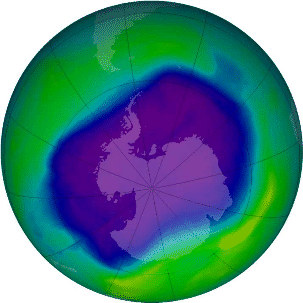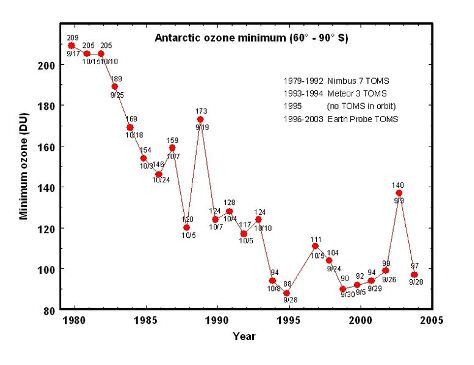臭氧消耗量 - 高级
章节大纲
-
What is the ozone layer?
::什么是臭氧层?The ozone layer protects the planet from harmful UV rays. Without this layer, serious issues arise.
::臭氧层保护地球免受有害的紫外线的危害,如果没有这一层,就会产生严重问题。Ozone Depletion
::臭氧消耗Many people confuse the “hole in the ozone” with “ ." Although the two are related in part, they are separate problems with separate effects and only partially overlapping causes, so they require separate solutions.
::许多人把“臭氧中的空洞”和“臭氧中的空洞”混为一谈。 虽然两者有部分关联,但它们是各自独立的问题,产生不同的影响,只是部分重叠的原因,因此它们需要分开的解决办法。At altitudes less than 5 kilometers, respiratory irritant “smog” ozone forms when sunlight reacts with pollutants. The Ozone Layer, at altitudes between 15 and 35 kilometers, forms when UV radiation interacts with oxygen, and shields life on Earth from 97-99% of the Sun’s damaging UV radiation.
::在不到5公里的高度,当阳光与污染物发生反应时,呼吸刺激性“烟雾”臭氧会形成。 臭氧层在15至35公里的高度,当紫外线辐射与氧相互影响时,会形成,并在太阳破坏性紫外线辐射的97-99 % , 保护地球上的生命。Ozone is both a threat and a gift ( Figure ). As a ground-level product of the interaction between sunlight and pollutants, it is considered a pollutant which is toxic to animals’ respiratory systems. However, as a component of the upper atmosphere , it has shielded us and all life from as much as 97-99% of the sun’s lethal UV radiation for as long as 2 billion years. The “hole” in the ozone develops in this thin upper ozone layer . How long will that protection continue? Let’s explore the problem of ozone depletion.
::臭氧既是一种威胁,也是一种礼物(图 ) 。 作为阳光和污染物相互作用的地面产物,它被视为对动物呼吸系统有毒的污染物。 然而,它作为上层大气的一部分,在长达20亿年的时间里保护了我们和所有生命免受高达97-99 % 的太阳致命紫外辐射的影响。 臭氧中的“洞”在这个薄薄的上层臭氧层中发展。这种保护还要持续多久?让我们探讨臭氧消耗问题。The ozone cycle involves the conversion of oxygen molecules to ozone (1 and 2) a slower reconversion of ozone molecules to oxygen (3). Interactions among ozone molecules or the presence of other reactive gases trigger the loss of ozone.
::臭氧循环涉及将氧分子转换为臭氧(1和2),将臭氧分子缓慢地将臭氧分子转换为氧(3)。 臭氧分子之间的相互作用或其他活性气体的存在引发臭氧的丧失。The ozone (O 3 ) layer forms when UV radiation strikes oxygen molecules (O 2 ) in the stratosphere, between 15 and 35 kilometers above the Earth’s surface. Even the highest concentrations of ozone are only about 8 parts per million, but ever since oxygenated the Earth’s atmosphere, allowing ozone-forming chemical reactions , this thin Ozone Layer has shielded life from the mutagenic effects of ultraviolet radiation – especially the more damaging UV-B and UV-C wavelengths ( Figure ).
::臭氧(O3)层在平流层的紫外线辐射分子(O2)撞击地球表面上方15至35公里之间的平流层氧气分子时形成。 即使是最高臭氧浓度仅约为百万分之八,但自从地球大气层氧化以来,这种薄臭氧层一直保护着生命免受紫外线辐射的诱发效应 — — 特别是破坏力更大的紫外线-B和紫外线-C波长(图示 ) 。Total global monthly ozone levels measured by three successive spectrometers (TOMS) show both seasonal variations and a general decline.
::连续三次光谱仪测量的全球月臭氧总量显示季节性变化和总体下降。The thickness of the ozone layer varies seasonally and across the Earth – thicker in Spring than in Autumn, and at the Poles compared to near the Equator. Ozone depletion describes two related declines in stratispheric ozone. One is loss in the total amount of ozone in the Earth’s stratosphere – about 4% per year from 1980 to 2001 ( Figure ). The second, much larger loss refers to the ozone hole – a seasonal decline over Antarctica ( Figure ), which has now lost as much as 70% of pre-1975 ozone levels. A much smaller “dimple” overt the North Pole has also shown a 30% decline. The Antarctic ozone hole occasionally affects nearby Australia and New Zealand after annual breakup. A secondary effect is the decline in stratosphere temperatures, because when ozone absorbs UV radiation, it is transformed into heat energy .
::臭氧层的厚度随季节和整个地球而异 — — 春天比秋天更厚,波兰比赤道附近地区更深。 臭氧消耗描述的是一个相关的臭氧消耗下降。 其中之一是地球平流层臭氧总量的损失 — — 从1980年到2001年每年约为4%(图 ) 。 第二个,更大的损失指的是臭氧洞 — — 南极洲的季节性下降(Figure ) , 南极洲的季节性下降已经损失了1975年前70%的臭氧水平。 北极上空的一个小得多的“小块”也显示出30%的下降。 南极洲臭氧洞在每年解体后偶尔会影响附近的澳大利亚和新西兰。 一个次要效应是平流层温度的下降,因为当臭氧吸收紫外辐射时,它会变成热能。On September 24, 2006 the seasonal ozone hole over the Antarctic covered a record daily area (29.5 million square kilometres or 11.4 million square miles). Blue and purple areas show the lowest ozone levels, and green, yellow, and red indicate successively higher levels.
::2006年9月24日,南极上空的季节性臭氧空洞覆盖了创纪录的每日面积(2 950万平方公里,即1 140万平方英里),蓝色和紫色地区臭氧水平最低,绿色、黄色和红色地区水平连续上升。Lowest annual values of ozone in the ozone hole decreased dramatically between 1980 and 1995. Before 1980, values less than 200 Dobson units were rare, but in recent years, values near 100 units are common. Unusually high temperatures in the Antarctic stratosphere may have caused the high reading in 2002.
::从1980年到1995年,臭氧空洞中臭氧的年度最低值急剧下降,1980年以前,只有不到200个多布森单位值是罕见的,但近年来,接近100个单位值是常见的,南极平流层异常高的温度可能在2002年引起高读数。The causes of ozone depletion are gases which unbalance the ozone cycle ( Figure ) toward the breakdown of ozone. Chlorine and bromine gases have increased due to the use of chlorfluorocarbons (CFCs) for aerosol sprays, refrigerants (Freon), cleaning solvents, and fire extinguishers. These ozone-depleting substances (ODS) escape into the stratosphere, and when UV radiation frees chlorine and bromine atoms, these unstable atoms break down ozone. Scientists estimate that CFCs take 15 years to reach the stratosphere, and can remain active for 100 years. Each chlorine atom can catalyze thousands of ozone breakdown reactions.
::由于使用氯氟化碳(CFCs)喷雾剂、制冷剂(Freon)、清洁溶剂和灭火器使用氯氟化碳(CFCs)、清洁溶剂和灭火器,这些消耗臭氧层物质(ODS)逃入平流层,当紫外线辐射释放氯和溴原子时,这些不稳定的原子会分解臭氧,科学家估计,氟氯化碳到达平流层需要15年时间,并且可以持续100年。Ozone depletion and the resulting increase in levels of UV radiation reaching earth could have some or all of the following consequences:
::臭氧消耗和由此导致的向地球辐射水平的上升可能会造成以下部分或全部后果:-
effects on human health
::对人类健康的影响 -
increase in skin cancers, including melanomas
::包括黑瘤在内的皮肤癌增加 -
increased incidence of cataracts
::白内障发病率增加 -
decreased levels of
vitamin
A
::维生素A水平下降 -
possible increase in levels of
vitamin D
produced by the skin
::皮肤生产的维生素D含量可能增加 -
reduced abundance of UV-sensitive nitrogen-fixing
::减少对紫外线敏感固氮的丰度 -
loss of crops dependent on these bacteria
::依赖这些细菌的作物损失 -
disruption of nitrogen cycles
::氮循环的中断 -
loss of plankton (supported by a supernova-related
extinction
event 2 million years ago)
::浮游生物损失(由200万年前与超新星有关的灭绝事件佐证) -
disruption of ocean
::影响海洋的海洋的
Most of these effects are based on the ability of UV radiation to alter sequences. It is this potential which has made the Ozone Layer such a gift to life ever since photosynthesis provided the oxygen to fuel its production. Its total loss would undoubtedly be devastating to nearly all life.
::这些影响大多基于紫外线辐射改变序列的能力,正是这种潜力使臭氧层成为生命的礼物,因为光合作用提供了氧以刺激其生产,其全部损失无疑将给几乎所有生命带来毁灭性影响。In 1987, 43 nations agreed in the Montreal Protocol to freeze and gradually reduce production and use of CFCs. In 1990, the protocol was strengthened to seek elimination of CFCs for all but a few essential uses. Today, Hydrochlorofluorocarbons (HCFCs – similar compounds which replace one chlorine with a hydrogen) have replaced CFCs, with only 10% of their ozone-depleting activity levels. Unfortunately, HCFCs are greenhouse gases , so their role as alternatives is a mixed blessing. HFCs (hydrofluorocarbons) are another substitute; because these contain no chlorine, they have no ozone-depleting activity, and their is less than HCFCs (though still significant). One HFC is currently used in automobile air conditioners in the U.S.
::1987年,43个国家在《蒙特利尔议定书》中同意冻结并逐步减少氟氯化碳的生产和使用。 1990年,该议定书得到加强,以寻求除少数基本用途之外的所有其他用途消除氟氯化碳。 如今,氢氯氟烃(HCFCs-类似化合物,用氢取代氯)取代了氯氟烃,只占其消耗臭氧活动水平的10%。 不幸的是,氟氯烃是温室气体,因此它们作为替代品的作用是喜忧参半的。 氟化烃(HFCs)是另一种替代物;因为这些物质不含氯,它们没有消耗臭氧的活动,而且低于氟氯烃(尽管仍然很重要 ) 。 目前美国汽车空调机中使用的一种氟化烃(HFFCs ) 。If ozone-depleting substances have been virtually eliminated, is ozone depletion no longer a problem?
::如果消耗臭氧物质实际上已经消除,那么臭氧消耗是否不再是一个问题?Unfortunately, we have not yet reached that point. Levels of CFCs in the atmosphere are beginning to decline, and ozone levels appear to be stabilizing ( Figure ) for years after 2000). Scientists predict that ozone levels could recover by the second half of this century; the delay is due to the long half-life of CFCs in the stratosphere. However, recovery could be limited or delayed by two unknowns:
::不幸的是,我们尚未达到这一水平,大气中的氟氯化碳水平开始下降,臭氧水平在2000年之后几年似乎正在稳定(图 ) 。科学家预测,臭氧水平可以在本世纪下半叶恢复;延迟的原因是,在平流层中氟氯化碳的半衰期很长。然而,回收可能受到两个未知因素的限制或拖延:-
Developing countries outside the Montreal Protocol could increase their use of CFCs.
::《蒙特利尔议定书》以外的发展中国家可以增加其氟氯化碳的使用。 -
According to scientists, global warming would cool the stratosphere and increase ozone depletion because cooler temperatures favor ozone decomposition.
::科学家们认为,全球变暖将使平流层降温,并增加臭氧消耗,因为冷却的温度有利于臭氧分解。
Summary
::摘要-
The ozone layer in the stratosphere – formed from O
2
– protects Earth’s life from mutagenic UV radiation.
::平流层中的臭氧层由O2形成,保护地球的生命免受诱变紫外线辐射的影响。 -
Ground-level ozone – formed from automobile exhaust and industry – is a component of smog, which irritates eyes and respiratory membranes.
::地面臭氧由汽车废气和工业形成,是烟雾的一部分,它刺激眼睛和呼吸膜。 -
Ozone depletion is a global reduction in the thickness of the ozone layer, caused by chlorine and bromine atoms which reach the stratosphere.
::臭氧消耗是进入平流层的氯和溴原子造成的臭氧层厚度全球下降。 -
The ozone hole is a seasonal thinning of ozone above the Antarctic.
::臭氧洞是南极上空臭氧的季节性稀薄。 -
CFCs in aerosol sprays, refrigerants (Freon), cleaning solvents, and fire extinguishers are the primary ozone-depleting substances (ODSs).
::喷雾剂喷雾剂、制冷剂(Freon)、清洁溶剂和灭火器中的氟氯化碳是主要的消耗臭氧层物质。 -
The 1987 Montreal Protocol has reduced the use of CFCs and ozone depletion.
::1987年《蒙特利尔议定书》减少了氟氯化碳的使用和臭氧消耗。 -
Chemical substitutes, though less harmful, still cause damage, and countries outside the Protocol may still add ODS to the atmosphere.
::化学代用品尽管危害较小,但仍然造成损害,《议定书》之外的国家仍可能将臭氧消耗物质添加到大气中。 -
Global warming would cool the stratosphere and increase ozone depletion, because cooler temperatures favor ozone decomposition.
::全球升温会冷却平流层,增加臭氧消耗,因为冷却温度会有利于臭氧分解。 -
Because fossil fuels are the source of many air pollutants, reducing their use is the key to solving air pollution problems.
::由于矿物燃料是许多空气污染物的来源,减少其使用是解决空气污染问题的关键。 -
Technology can help by developing alternative energy sources, increasing fuel efficiencies, and improving pollution control.
::技术可以通过开发替代能源、提高燃料效率以及改进污染控制来提供帮助。 -
Governments can help by legislating fuel efficiencies and pollution control, urban planning, and forging agreements with other governments.
::政府可以通过立法提高燃料效率和控制污染、城市规划以及与其他政府签订协议来提供帮助。
Review
::回顾-
Define ozone depletion and explain its causes.
::界定臭氧消耗的定义并解释其原因。 -
Explain the consequences of ozone depletion.
::解释臭氧消耗的后果。 -
Why are international treaties, such as the Montreal Protocol and the Kyoto Treaty, so important in solving air pollution problems?
::为什么诸如《蒙特利尔议定书》和《京都议定书》等国际条约在解决空气污染问题方面如此重要? -
Chart the air pollution problems discussed in the
Natural Resources
concepts together with a primary cause and an important prevention practice for each.
::说明在自然资源概念中讨论的空气污染问题,以及一个主要原因和每个原因的一个重要预防做法。
Problem Major Cause Major Prevention Practice Global Dimming Light Pollution Smog Acid Rain Ozone Depletion -
effects on human health





